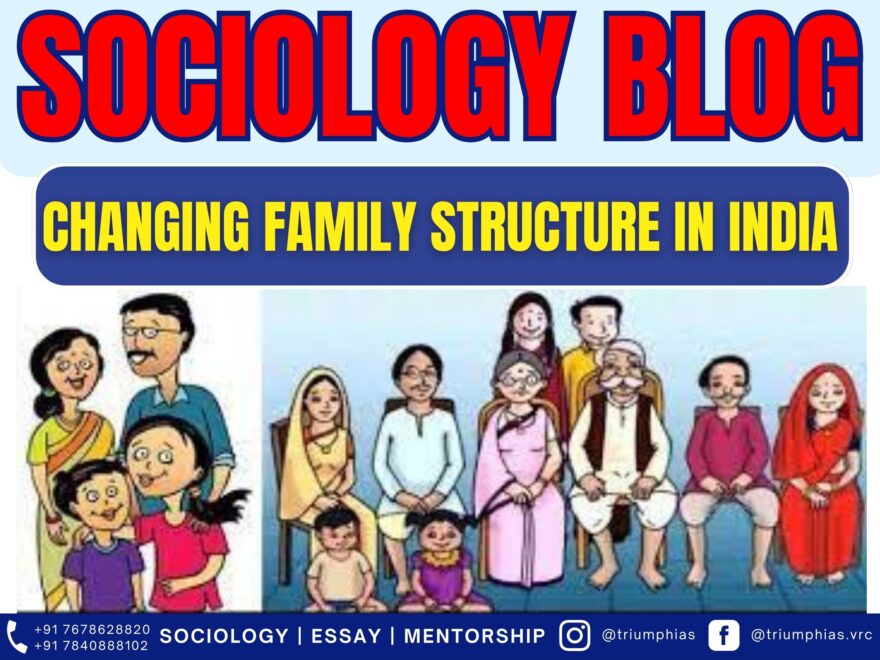
CHANGING FAMILY STRUCTURE IN INDIA
(Relevant for Sociology Syllabus: Paper 1 – Systems of Kinship:- Contemporary trends, Family and marriage in India)
(Relevant for GS Syllabus: Paper1- Effects of globalization on Indian society)
CHANGING FAMILY STRUCTURE IN INDIA
- Families have both structure and function. Like the skeleton and muscles in a body, the structure is what gives a family it’s size and shape. Also, like organs within the body that perform necessary functions to keep the body working, there are certain necessary functions that keep families healthy. It sees society as a complex system whose parts work together to promote solidarity and stability.
- It asserts that our lives are guided by social structures, which are relatively stable patterns of social behaviour. Social structures give shape to our lives – for example, in families, the community, and through religious organizations and certain rituals, or complex religious ceremonies, give structure to our everyday lives. Each social structure has social functions or consequences for the operation of society as a whole.
- Social structures consist of social relationships, as well as any social institutions within a society. One example of a social structure is a social class (upper-class, middle-class, and poor). Another example of a social structure is the different levels of government. Family, religion, law, economy, and class are all social structures.
INDIA AND ITS FAMILY STRUCTURE
- India has a rich family structure with a patrilineal background, which help the family members to sustain a life with kinship groupings. Earlier, mostly joint families were found where family members live together under one roof. They all mutually work, eat, worship and co-operate each other in one or the other way.
- This also helps the family to get strong mentally, physically and economically, the children also get to know about the values and traditions of the society from their grandparents and elders. The family system has given a lot of importance in India and has worked more often to make the bonding among families stronger.
- The family system has given a lot of importance in India and has worked more often to make the bonding among families stronger. Meanwhile, urbanization and westernization had its influence on the basic structure of the Indian family structure. The division of the joint family into smaller units is not the symbol of people rejecting this traditional structure. The circumstances and conditions also made the need for people to split the family.
- The family as a social institution has been undergoing change. Both in its structure and functions changes have taken place. In India, as in many traditional societies, the family has been not only the centre of social and economic life but also the primary source of support for the family members.
- The increasing commercialization of the economy and the development of the infrastructure of the modern state have introduced a significant change in the family structure in India in the 20th century. Especially, the last few decades have witnessed important alterations in family life.
- India’s fertility rate has fallen, and couples have begun to bear children at a later age. At the same time, life expectancy has increased, resulting in more elderly people who need care. All of these changes are taking place in the context of increased urbanization, which is separating children from elders and contributing disintegration of family-based support systems.
FACTORS AFFECTING FAMILY STRUCTURES
- Change in Fertility: An inevitable outcome of declining fertility rates and increasing age at first birth in most of the countries in the world, including India, is a reduction in family size. Fertility declined due to the combined effect of substantial socio-economic development achieved during the last two decades and the effective implementation of family planning programmes.
- Hence, it has become irrational for many people to have large families as the cost of children is increasing. In traditional societies, where human labour was a source of strength to the family, more children were preferred to fewer. But as the economic contribution from the children in a family decreased, because of a move away from agriculture, the need for large numbers of children decreased.
- Improvements in health care and child survival also contributed. The emphasis was on the quality of life rather than the number of children, a new concept added to the family.
- CHANGE IN AGE OF MARRIAGE: In many countries in the world where significant declines infertility are being experienced, reductions in the proportion of people never married have often coincided with or preceded declines in marital fertility. A substantial increase in the proportions never married, among both males and females, at young ages, has been noted in many countries. A consequence of the increase in the proportion of never-married young adults is the gradual upward trend of the average age at marriage. Postponement of marriage among females resulted in the postponement of childbearing with a reduction in family size.
- CHANGE IN MORTALITY: Mortality declines, particularly infant mortality, everywhere preceded the decline of fertility. Improved survival rates of children mean that when women reached the age of 30 they increasingly had achieved the completed family size they desired. Earlier, much larger numbers of births were required to achieve the desired completed family size.
- In the last three decades, infant mortality has declined significantly in every country and this trend undoubtedly influenced the fertility decline. Mortality decline, followed by fertility decline, altered the age structure of the population and also the structure within individual families.
- MARRIAGE DISSOLUTION: It is no longer the case that all marital unions, whether formal or informal reach final dissolution through death. A considerable proportion of unions are disrupted suddenly for reasons such as desertion, separation or divorce. An obvious failure in a family relationship is where husband and wife cease to live together.
- Those women who are divorced at latter ages mostly remain single for the rest of their lives and live with their dependents. The idea that when a couple has children it will be less likely to divorce is widely accepted in most societies. However, it is believed that in the last couple of years even in most of the Asian cultures, including India, a growing proportion of divorces involve couples with young children (Goode 1993).
- PARTICIPATION OF WOMEN IN ECONOMIC DEVELOPMENT: The commercialization process which opened markets in many developing countries has succeeded in replacing the traditional co-operation in the economic relationship, with that of competition.
- In this process, the social institutions in these countries found themselves in conflict with the key aspects of the new economic systems. The economics of the family and the sexual division of labour within the family is very much determined by opportunities in the labour market. The developing economies of system India have facilitated the freeing of women from household chores and their entrance to the labour market.
- The declining ability of men to earn a ‘family wage’ along with the growing need for cash for family maintenance has resulted in an increasing number of female members (particularly the wife) in the family engaging in economic activities (Lloyed and Duffy 1995).
- Talcott Parsons, theoretical insights on the family have attracted widest attention and deliberation. Parsons (1954, 1956) argues that modern industrial society has led to the growth of what he calls “isolated nuclear family”. This family is structurally isolated as it does not form an integral part of the wider kinship group.
- Family is a very fluid social institution and in the process of constant change. The modern family or, rather the post-modern family is also witnessing several new forms of it cropping up. Modernity is witnessing the emergence of same-sex couples (LGBT relationship), cohabitation or live-in relations, single-parent households, a large chunk of divorced living alone or with their children.
To master these intricacies and fare well in the Sociology Optional Syllabus, aspiring sociologists might benefit from guidance by the Best Sociology Optional Teacher and participation in the Best Sociology Optional Coaching. These avenues provide comprehensive assistance, ensuring a solid understanding of sociology’s diverse methodologies and techniques.
META TAGS:
changing family structure changing family structure, age of marriage, contemporary trends contemporary trends, family and marriage in India family and marriage in India, family planning family planning, family support system family support system, fertility rate fertility rate, globalization globalization, India India, joint family joint family, kinship kinship, marriage dissolution marriage dissolution, mortality mortality, Sociology Sociology, urbanization urbanization, westernization westernization
Why Vikash Ranjan’s Classes for Sociology?
Proper guidance and assistance are required to learn the skill of interlinking current happenings with the conventional topics. VIKASH RANJAN SIR at TRIUMPH IAS guides students according to the Recent Trends of UPSC, making him the Best Sociology Teacher for Sociology Optional UPSC.
At Triumph IAS, the Best Sociology Optional Coaching platform, we not only provide the best study material and applied classes for Sociology for IAS but also conduct regular assignments and class tests to assess candidates’ writing skills and understanding of the subject.
Choose The Best Sociology Optional Teacher for IAS Preparation?
At the beginning of the journey for Civil Services Examination preparation, many students face a pivotal decision – selecting their optional subject. Questions such as “which optional subject is the best?” and “which optional subject is the most scoring?” frequently come to mind. Choosing the right optional subject, like choosing the best sociology optional teacher, is a subjective yet vital step that requires a thoughtful decision based on facts. A misstep in this crucial decision can indeed prove disastrous.
Ever since the exam pattern was revamped in 2013, the UPSC has eliminated the need for a second optional subject. Now, candidates have to choose only one optional subject for the UPSC Mains, which has two papers of 250 marks each. One of the compelling choices for many has been the sociology optional. However, it’s strongly advised to decide on your optional subject for mains well ahead of time to get sufficient time to complete the syllabus. After all, most students score similarly in General Studies Papers; it’s the score in the optional subject & essay that contributes significantly to the final selection.
“A sound strategy does not rely solely on the popular
Opinion of toppers or famous YouTubers cum teachers.”It requires understanding one’s ability, interest, and the relevance of the subject, not just for the exam but also for life in general. Hence, when selecting the best sociology teacher, one must consider the usefulness of sociology optional coaching in General Studies, Essay, and Personality Test.
The choice of the optional subject should be based on objective criteria, such as the nature, scope, and size of the syllabus, uniformity and stability in the question pattern, relevance of the syllabic content in daily life in society, and the availability of study material and guidance. For example, choosing the best sociology optional coaching can ensure access to top-quality study materials and experienced teachers. Always remember, the approach of the UPSC optional subject differs from your academic studies of subjects. Therefore, before settling for sociology optional, you need to analyze the syllabus, previous years’ pattern, subject requirements (be it ideal, visionary, numerical, conceptual theoretical), and your comfort level with the subject.
This decision marks a critical point in your UPSC – CSE journey, potentially determining your success in a career in IAS/Civil Services. Therefore, it’s crucial to choose wisely, whether it’s the optional subject or the best sociology optional teacher. Always base your decision on accurate facts, and never let your emotional biases guide your choices. After all, the search for the best sociology optional coaching is about finding the perfect fit for your unique academic needs and aspirations.
Follow us :
🔎 https://www.instagram.com/triumphias
🔎https://www.youtube.com/c/TriumphIAS
🔎https://t.me/VikashRanjanSociology
Find More Blogs
| Compare and contrast Karl Marx’s and Max weber’s | Karl Marx- Historical Materialism |
| Position of Women In the Modern Indian Society | Sociology: Social system and pattern variables |



201 comments